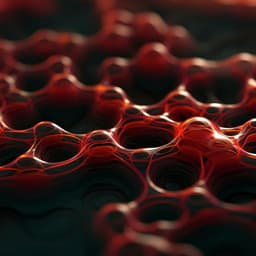Introduction
Wearable electronics with mechanical deformability and intelligent capabilities are increasingly important. Visual displays are a core component, and wearable displays offer advantages like flexibility, portability, and skin conformability. Existing technologies, including LCDs, OLEDs, QLEDs, PeLEDs, and ACEL devices, each have limitations. LCDs, while durable and bright, lack flexibility. OLEDs, QLEDs, and PeLEDs offer better color and flexibility but suffer from material instability and high fabrication costs due to stringent environmental controls and electrode work function requirements. ACEL devices are simpler to manufacture, more deformable, and offer low power consumption and long lifetimes. However, their limited color capabilities and high driving voltages hinder practical applications. Commercial ACEL phosphors have broad FWHM (>50 nm) and limited color range, resulting in poor color purity and restricted gamut. Lead halide perovskite nanoparticles (PeNPs) offer potential as color conversion layers due to their high absorption, quantum yield, tunable emission, and narrow FWHM. However, challenges remain in creating ultrathin, stretchable, large-area, and colorful displays for wearable electronics due to complex multilayer structures and high driving voltages.
Literature Review
The existing literature highlights the need for flexible and stretchable display technologies for wearable electronics. While LCDs dominate current markets, their rigidity limits applications in flexible and wearable devices. OLEDs and QLEDs have shown progress in flexibility and color gamut, but their stability and fabrication costs remain challenges. ACEL devices, with their simplicity and deformability, present a promising alternative. However, their limited color options and high operating voltages require improvement. Recent research has explored using perovskite nanocrystals to enhance ACEL device color purity and tunability. These studies demonstrate the potential of perovskite materials, but creating ultrathin, stretchable, and full-color displays remains a significant hurdle.
Methodology
This study introduces a full-color perovskite-based alternating-current electroluminescent (PeACEL) device. A new class of EL phosphors, PeNPs-coated ZnS (PeZS), is developed to achieve efficient electrical excitation of PeNPs via total intraparticle energy transfer. The PeZS phosphors are synthesized by combining blue ZnS phosphors and PeNPs. CsPbX3 (X = Cl, Br, I) nanoparticles are synthesized using a modified hot injection method with (3-aminopropyl) triethoxysilane (APTES) as a capping ligand. The washed PeNPs are mixed with pristine ZnS, allowing attachment via the reaction between APTES and ZnS hydroxyl groups. Additional APTES enhances environmental stability. The resulting PeZS phosphors exhibit highly monochromatic emission. Energy-dispersive X-ray spectroscopy and transmission electron microscopy confirm the composition and structure of the core-shell particles. X-ray diffraction shows the presence of both ZnS and CsPbX3 structures, with reduced ZnS peak intensity indicating a dense PeNP coating layer. The core-shell structure facilitates efficient energy transfer from ZnS to PeNPs via FRET, confirmed by time-decay studies. Rigid PeACEL devices are fabricated using a sandwich structure with indium tin oxide and silver electrodes, with PeZS and BaTiO2 dispersed in PDMS as the emission layer. Stretchable PeACEL devices utilize spray-coated AgNWs on pre-strained SEBS substrates as transparent electrodes, with PeZS embedded in SEBS as the emission layer. Patte3rned devices are fabricated using laser-cut templates and double-sided transparent electrodes. The user-interactive skin display is demonstrated by integrating PeACEL devices with pressure, temperature, and other sensors. A visual temperature-monitoring system is created by integrating a micro temperature sensor and multicolour PEACEL devices.
Key Findings
The PeACEL devices demonstrate narrowband emission (FWHM <37 nm), tunable emission from 468–694 nm, high brightness (>500 cd m⁻²), and ultrathin (95 µm) and highly stretchable (400%) designs with double-sided light emission. The PeZS phosphors significantly expand the color gamut of ZnS-based ACEL devices by 2.1-fold, and up to 2.5-fold when combined with commercial blue ZnS. The PeACEL devices show high-frequency stability, unlike commercial ZnS phosphors, exhibiting no color drift with changing frequency. The luminance of PeACEL devices is comparable to or exceeds that of commercial ACEL devices across blue, green, and red emissions. The red PeACEL device shows a lower turn-on voltage and higher brightness (4.1 times) than the orange ACEL device. The PeACEL devices maintain brightness up to 400% strain, showing reversible intensity fluctuations during cyclic stretching. The patterned PeACEL devices exhibit high flexibility and stretchability. The integrated user-interactive skin displays demonstrate instantaneous pattern or color changes. The visual temperature-monitoring system shows real-time temperature response via color changes in the PeACEL devices. The soft robotic system successfully displays tactile information using the multicolour PeACEL device. The PeACEL devices demonstrate high stability, maintaining >88% luminance after 60 days of testing.
Discussion
The results demonstrate that the novel PeZS phosphors and device fabrication strategy successfully address the limitations of existing flexible display technologies. The combination of high color purity, tunability, brightness, and stretchability makes the PeACEL devices highly suitable for wearable applications. The successful integration with sensors showcases their potential for creating user-interactive displays and real-time health monitoring systems. The high stability and durability of the devices are crucial for long-term use in wearable electronics. The expanded color gamut, achieved through the unique energy transfer mechanism, significantly enhances the potential for full-color displays. Future research could focus on further improving device efficiency, exploring new perovskite compositions for wider color ranges, and developing advanced integration techniques for more complex wearable systems.
Conclusion
This study successfully developed high-performance multicolour stretchable PeACEL devices with excellent color purity, brightness, stability, flexibility, and stretchability. The devices' integration into user-interactive displays and a temperature-monitoring system highlights their broad application potential in wearable electronics, soft robotics, and biomedical monitoring. Future work will explore further improvements in device performance and integration with more sophisticated sensing and control systems.
Limitations
While the PeACEL devices show excellent performance, some limitations exist. The current study focused on small-area devices; scaling up to larger areas for practical applications requires further investigation. Long-term stability under various environmental conditions needs more comprehensive evaluation. The power consumption, although relatively low, could be further optimized for extended battery life in wearable devices. The integration with various sensors might need adjustments for different applications and types of sensors.
Related Publications
Explore these studies to deepen your understanding of the subject.







